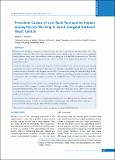Please use this identifier to cite or link to this item:
https://hdl.handle.net/20.500.14356/1886Full metadata record
| DC Field | Value | Language |
|---|---|---|
| dc.contributor.author | Adhikari, S | - |
| dc.contributor.author | Dhakal, G | - |
| dc.date.accessioned | 2023-05-30T07:40:19Z | - |
| dc.date.available | 2023-05-30T07:40:19Z | - |
| dc.date.issued | 2014 | - |
| dc.identifier.citation | AdhikariS., & DhakalG. (2015). Prevalent Causes of Low Back Pain and its Impact among Nurses Working in Sahid Gangalal National Heart Centre. Journal of Nepal Health Research Council. https://doi.org/10.33314/jnhrc.v0i0.548 | en_US |
| dc.identifier.issn | Print ISSN: 1727-5482; Online ISSN: 1999-6217 | - |
| dc.identifier.uri | http://103.69.126.140:8080/handle/20.500.14356/1886 | - |
| dc.description | Original Article | en_US |
| dc.description.abstract | Abstract Background: Nursing is considered as caring profession and nurse is a person who provides holistic care to the individual or community. Nurse’s jobs vary from simple task to more complex one and are at risk of various occupational health problems. Among those, musculoskeletal problem including low back pain (LBP) is commonest one. Thus this study examines the prevalence and perceived causes of low back pain and its impact among the nurses working in national heart centre. Methods: A descriptive cross-sectional study design was used. After informed verbal consent, 50 nurses were selected purposively. Semi structured self administered questionnaires with single and multiple response items were distributed to them and were collected next day. Response rate was 100%. Data was analyzed using the Statistical Package for the Social Sciences (SPSS) version 16 for windows. Descriptive statistics i.e., percentage, mean and chi square was used to interpret the data. For multiple responses, percentage was calculated in terms of total responses therefore exceeds 100%. Results: Among 50 nurses, 78% of nurses were suffering from LBP. Study found that LBP was predominant among married nurses (88%) compared to unmarried (69%). Prolonged standing (82%), heavy physical workload and frequent bending & twisting (51% each) were some perceived causes of low back pain. Due to LBP, 44% were not able to perform their job properly, 33% became less productive, 28% had restriction in work and 26% could not provide quality care to the patient. Conclusions: Three fourth of nurses working at national heart centre were suffering from low back pain which indicates high prevalence. Therefore it is recommended to maintain proper body mechanics and use supportive devices like back belts, knee cap, and chair with back rest during patient care.  Keywords: low back pain; national heart centre; nursing care; occupational health problem. | en_US |
| dc.language.iso | en | en_US |
| dc.publisher | Nepal Health Research Council | en_US |
| dc.relation.ispartofseries | Sep-Dec, 2014;548 | - |
| dc.subject | Low back pain | en_US |
| dc.subject | National heart centre | en_US |
| dc.subject | Nursing care | en_US |
| dc.subject | Occupational health problem | en_US |
| dc.title | Prevalent Causes of Low Back Pain and its Impact among Nurses Working in Sahid Gangalal National Heart Centre | en_US |
| dc.type | Journal Article | en_US |
| local.journal.category | Original Article | - |
| Appears in Collections: | Vol. 12 No. 3 Issue 28 Sep - Dec, 2014 | |
Files in This Item:
| File | Description | Size | Format | |
|---|---|---|---|---|
| 548-Article Text-942-1-10-20150420.pdf | Fulltext Download | 177.91 kB | Adobe PDF |  View/Open |
Items in DSpace are protected by copyright, with all rights reserved, unless otherwise indicated.
